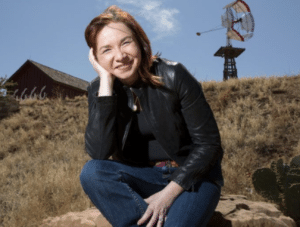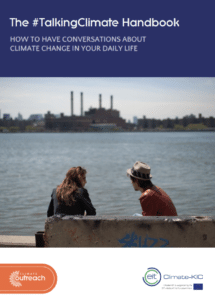Most people believe climate change is real. But they don’t know what to do about it. Here’s how to link awareness to action with climate solutions like solar.
Talking about climate change won’t solve the problem, but it’s a good place to start.
Why do we care more about natural disasters in our own cities and states than halfway around the world? As climate scientist Katherine Hayhoe explains: “That’s a problem called psychological distancing.”
This is the same reason why an estimated 72% of American adults believe global warming is real, but only 43% believe it will affect them personally, according to an ongoing study of climate opinion by the Yale Program on Climate Change Communication.
Until we see the signs of climate change in our own backyards, we just don’t get it. But do we have to wait for an unmitigated climate disaster in our local area before we do something about it? Hayhoe says no.

“The most important thing you can do about climate change is what we are NOT doing: talk about it,” Hayhoe said on a recent webinar for the University of Central London’s Institute of Sustainable Resources. “It’s not sufficient, obviously, but it’s a necessary first step. It knocks over the first domino in a long train of dominoes that leads us to a brighter future.”
Despite the increased coverage of climate issues, only 35% of the American public say they talk about climate change “at least occasionally.”
Climate cocktail conversations?
A UN “Champion of the Earth,” Hayhoe is also an evangelical Christian who lives and teaches in Texas. Her book, Saving Us: A Climate Scientist’s Case for Hope and Healing in a Divided World, has been called one of the most important books to date on climate change. Not because of doomsday facts but because of its message of hope.
Hayhoe’s perspective is grounded in data, but her communications style is warm and personable. Instead of spewing facts to her audiences, she takes a different route to changing people’s attitudes on climate by first seeking to find common ground.
You know, the kind of conversation you used to strike up at a cocktail party filled with people of diverse opinions. Remember those?
“It’s about connecting with our hearts, not our heads,” Hayhoe explains. “To change an adult or anybody past the age of about 10 years old is almost impossible. But we don’t have to do that.”
“If they’re a human living on Planet Earth they have every reason to care about climate change. So we have to connect with what they care about,” she says. “If they hunt or fish, they have every reason to care about climate change. Whoever they are, whatever they care about–we can help them care about climate…by having a conversation about our shared values.”
Shared Values? That sounds deep…
Let’s go back to the cocktail party. You don’t strike up a conversation with someone you don’t know by going deep on politics. You ask about their lives, their family, their work, their interests, first.
It’s no different when talking about climate change.

Rule #1 is: Respect your conversational partner and find common ground.
Be curious about your audience. Ask questions. What do they care about? Listen to their answers. Really listen. There you will find some common ground to build on.
Making the Leap to Climate Solutions
There’s a natural fear that the more we talk about climate change, the more disheartened we will become. Even though a majority of people believe climate change is happening, only 50% think they can do anything about it. This is a problem Hayhoe refers to as “solution aversion” — meaning the solution seems to painful or risky.
This makes trustworthy communications about climate solutions paramount.
People tend to filter their information through three different lenses:
- Is the information relevant to my needs?
- Is it believable?
- Is the message respectful and compelling?
That’s why it’s important that the solution being presented is proven, and solutions like rooftop solar and electric vehicles clearly are. A strong educational content campaign communicates can be incredibly powerful in this regard. IF it’s relatable, believable and hype-free.
Know Your Audience
Finding the right message, tone and delivery for your message boils down to how well you know your audience. Some of this is obvious. Talking about climate solutions to a homeowner differs from how we would talk to a business. Consumers care about climate for the changes it may cause to their lifestyle, their livelihood and their families.
The savings message of solar is important, for instance, but a growing segment of the consumer audience now feels a personal sense of responsibility for the planet – and a desire to take some kind of definitive action. So does it make sense anymore to hammer away at a savings message without linking to a climate action benefit?
When it comes to B2B, the audience is still made up of people. But their motivation for adopting climate solutions is grounded in the practical risks their business is now expected to face in the event of extreme weather. Any climate solution has to address the need for resiliency — and make economic sense. But we can also connect their decision to the pressing need for businesses to take action on curbing carbon emissions.
Segmenting your business audience by the industry they’re in — and the issues they care most about — is a highly effective way to build a successful B2B content marketing campaign. Geographic segmentation also helps.
A commercial real estate owner in suburban Chicago facing dwindling occupancy rates needs to generate higher net operating income. A vineyard owner in California worries about fires. Yet both may come to the conclusion that offsite solar is a good way to address their concerns while doing something tangible for the planet at the same time.
The bottom line is that your audiences care about the climate for different reasons. Knowing what those reasons are – and developing content that speaks to those motivations – is the surest path to convincing them to take action.
Ready to develop some great content for your audiences?
We’re ready to help. Contact us to get started today.
For more information on how to talk about climate change, download the #TalkingClimate Handbook.



